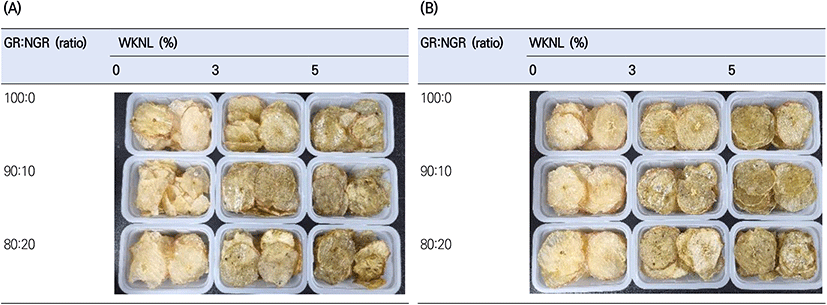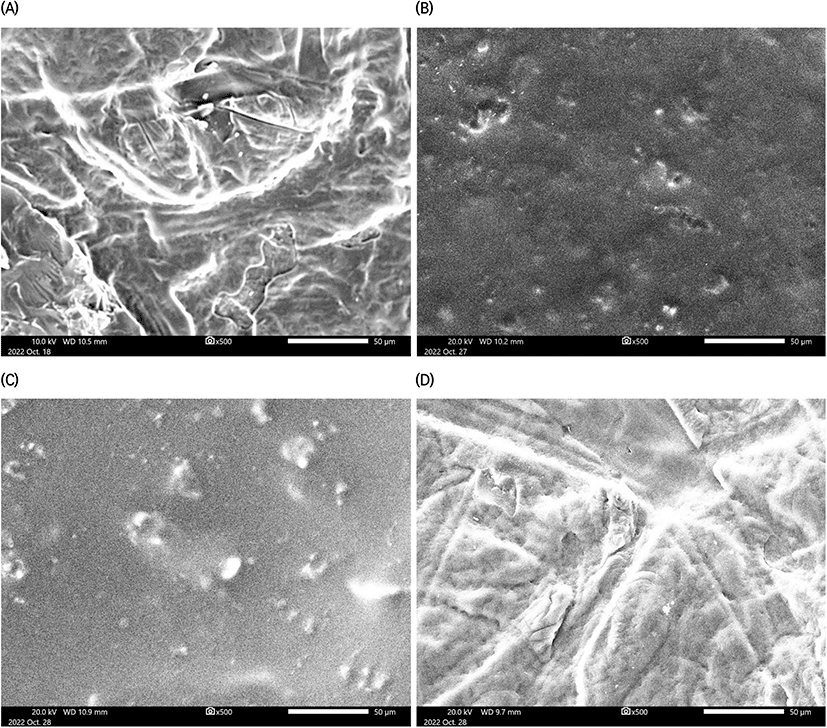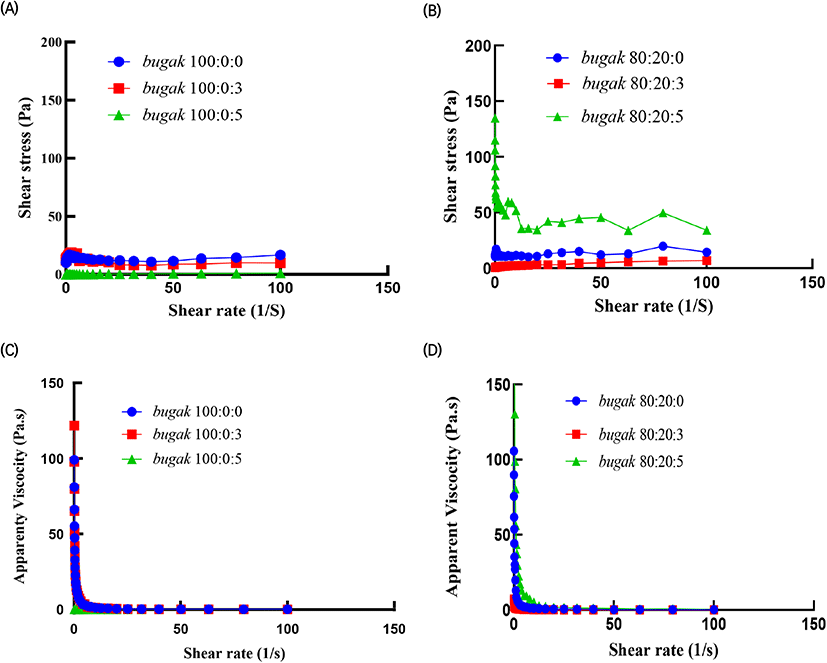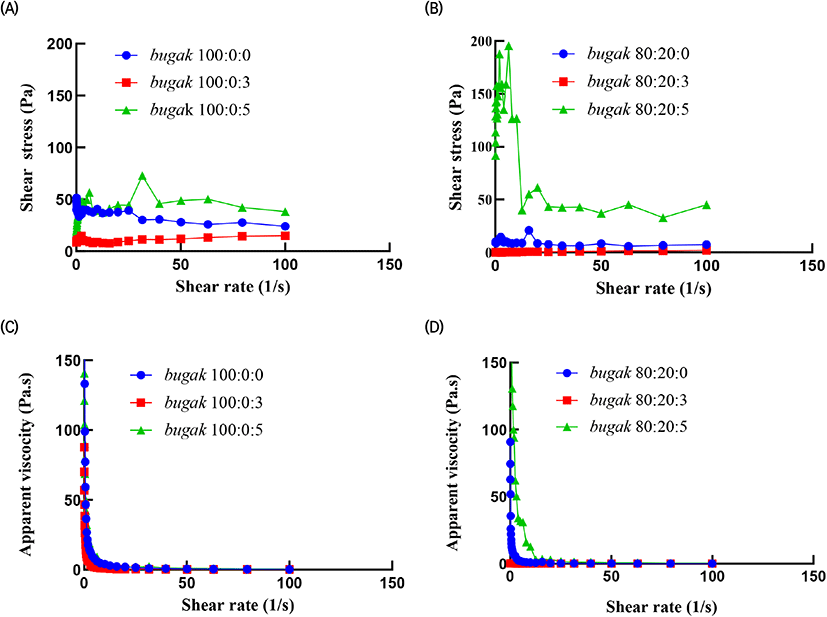1. Introduction
Among Korean traditional foods, the bugak can be classified as dried or fried ones (KFRI, 2020). Dried bugak is made by coating raw food with glutinous rice powder and is not as popular as fried bugak, but the raw chip market has been expanding. These chips contain various nutritional ingredients depending on the type of raw material (i.e., the food ingredient) used. Fruits and vegetables are healthy food materials that can be used as raw food and in future foods. Apples play a significant role in fundamental research concerning the production of upcycled foods (Zhang et al., 2019). Apples that are difficult to distribute due to poor taste and low grade need to be used for pressed juice and manufacturing products in the form of dried chips, a convenient food. Among apples, Hongro is harvest earlier than Fuji and is used less as a processed product than as raw fruit. The peels of Hongro apples are rich in phenolic antioxidants and non-starch polysaccharides, including pectin, which are cell wall components (Choi and Chung, 2019). Apple chips deteriorate in quality during storage, therefore, it is necessary to resolve this by preventing moisture absorption rate and loss of nutrients and improving sensory quality characteristics during storage.
Among milling technologies, superfine grinding to produce micrometer and nanometer powders has attracted attention (Xiao et al., 2022). Unlike conventional grinding, superfine grinding has a particle size of 19.08 μm, which affects pasting and thermal properties. As particles become smaller, the gelatinization temperature and various viscocity values, including peak visibility, decrease (Zhang et al., 2021). Thus, during steam treatment of the coating powder, it can be gelatinized in a short time. Superfine grinding can improve functional features such as water-holding capacity and oil-holding capacity (Zhao et al., 2018; Zhang, 2020). Superfine ground powder of water dropwort (Oenanthejavanica) is an excellent ingredient for drinks and as particle size decreases, soluble polysaccharide content and total dissolution increases significantly. Also, the smaller the particles, the higher the water-holding capacity and the lower the oil-binding capacity (He et al., 2019). Superfine grinding is also thought to increase dispersion properties of cell wall components to reduce sedimentation when making drinks and increase stability to prevent layer separation (Kang, 2020). Thus, this method can be applied to the manufacture of batters using residues and coating material after extraction.
This study used superfine ground powders such as non-glutinous rice (NGR) and Wasabia koreana Nakai leaf (WKNL) powder and coating materials prepared by modifying the bugak manufacturing method of the traditional food. They were prepared by varying the the relative proportion of food-coating materials. In particular, the traditional method of using 100% glutinous rice (GR) powder is replaced with up to 20% NGR powder, and the quality characteristics of dried and air-fried apple bugak prepared by using WKNL powder with 3% and 5% of the total rice powder were investigated.
2. Materials and methods
Hongro apples were purchased from orchards (Imgye, Gangwon-do, Korea) in August. The superfine powder was used for experiments after finally grinding of GR, NGR, and WKNL using a superfine pulverizer (Fluid bed jet mill, Korea Powder System Co., Ltd., Incheon, Korea). For chemical composition analysis, Folin-Ciocalteu agent, sodium carbonate, diethylene glycol, 2,2′-diphenyl-1-picryl-hydrazyl (DPPH), and gallic acid were purchased from Sigma Aldrich (St. Louis, MO, USA).
GR, NGR, and WKNL were first ground to a coarse texture using a cutter mill, to a fine powder using a blade mill and an air-classified mill (ACM-185, Korea Powder System Co., Ltd., Incheon, Korea), and superfine powder using an air jet mill (Fluid bed jet mill, Korean Powder System Co., Ltd., Incheon, Korea). The average median diameter (D50) of the prepared superfine powder was 10.01, 10.68, and 7.14 μm in GR, NGR, and WKNL powder, respectively.
Apples were cut into 2 mm pieces, blanched at 100°C for 2 min, immersed in cool water, coated with superfine powder, heat treated with hot water-steam above 100°C for 10 min, and dried at 55°C for 15 h to produce dried apple bugak. Air fried bugak was manufactured by heat-treating the dried bugak at 160°C for 2 min with an air fryer (MEA-T10LW, Guangdong Tredy Electrical Co., Ltd., Guangzhou, China). The ratios of the coating powder used to manufacture the bugak were 100%, 90% and 80% of superfine GR powder, 0%, 10% and 20% of superfine NGR powder, 0%, 3%, and 5% of superfine WKNL powder (i.e., the treatments were 100:0:0 (contol), 100:0:3, 100:0:5, 90:10:0, 90:10:3, 90:10:5, 80:20:0, 80:20:3, and 80:20:5% GR:NGR:WKNL. The prepared bugak (Fig. 1) was ground to a powder (FM-909, Hanil electric., Bucheon, Korea) and passed through a 40 mesh size. This (hereafter referred to as bugak powder or samples) was used for all analyses.

A color difference meter (CM-5, Konika Minolta Inc., Tokyo, Japan) was used to measure Hunter L (lightness), a (red/greenness) and b (yellowness). Each sample was measured ten times to obtain an average value. The L, a, and b values of the standard white plate used at the time were 92.97, −0.67, and 3.31, respectively.
Scanning electron microscope (SWM; SM-IT500LA, JEOL Ltd., Tokyo, Japan) was used to examine the surface morphology of the apple bugak with a few modifications to the method described by Aradwad et al. (2022). Prior to the images analysis, samples of both bugak were placed on the surface of a two adhesive tapes and attached to aluminum stubs using double-coated carbon taps prior to images analysis (SCD005, Leica Microsystem GmbH A-170, Vienna, Austria). The samples were observed under high vacuum with a magnification of 500× and accelerated voltage of 15 kV and 20 kV under high vacuum mode.
Water absorption capacity (WAC) and oil absorption capacity (OAC) were analysed using the modified approach of Wang et al. (2022). The water absorption capacity was determined by mixing 1.0 g of bugak powder with 25 mL of distilled water in a centrifuge tube, waiting for 30 min for the mixture to be completely mixed, and centrifuged at 2,500 rpm for 10 min. After centrifugation, the supernatant was removed, and WAC was calculated using the following equation:
The oil absorption capacity was determined in the same way by using soybean oil (CJ, Corp., Incheon, Korea) instead of distilled water.
A hot water extract was prepared by adding 1 g of bugak powder to 100 mL of distilled water at 95°C in water bath (C-WBE-B, Changshin Science, Seoul, Korea) for 1 h. The extract mixture was cooled, filtered (Whatman No. 2), and used for further analysis. The total polyphenol content in the extract was analysed by adding 0.25 mL of the Folin-Ciocalteu reagent and 2 mL of distilled water to 0.25 mL of the sample, waiting for 3 min, and then adding 0.25 mL of 20% Na2CO3. The solution was left to react at 37°C for 30 min in a water bath, after which absorbance was determined at 750 nm using a spectrophotometer (Cary 8454 UV-Vis, Agilent Technologies Inc., Santa Clara, CA, USA). Gallic acid was used as the standard and polyphenol concentration was estimated using the calibration curve. The total flavonoid content (TFC) was determined by adding 10 mL of diethylene glycol and 1 mL of 1 N NaOH to 1 mL of the hot water extract and allowing it to react at 37°C for 1 h in a water bath, and after which absorbance was measured at 420 nm using a spectrophotometer. Naringin was used as a standard for flavonoid calculation.
The antioxidant activity of hot water bugak powder extract was tested based on its 1,1-diphenyl-2-picryl-hydrazyl (DPPH) and 2,2'-azino-bis (3-ethylbenzothiazoline-6-sulfonic acid (ABTS) radical scavenging activity. Blois’ (1958) method was used, in which 0.8 mL of 0.2 mM 1,1-diphenyl-2-picryl-hydrazyl (DPPH) was added to 0.2 mL of the extract, mixed thoroughly, and left to stand at room temperature for 10 min. A spectrophotometer (Cary 8454 UV-Vis, Agilent Technologies Inc., Santa Clara, CA, USA) was used to detect absorbance at 525 nm. The ABTS radical scavenging activity was determined using Kim and Lee’s (2016) technique. 7.4 mM ABTS diammonium salt and 2.6 mM K2S2O8 were mixed and kept in the dark for 24 h to produce radicals. The absorbance of a solution of ABTS diluted with phosphate-buffered saline (pH 7.4) was determined at 732 nm using a spectrophotometer before 2 mL of this solution was added to 0.2 mL of the extract in a test tube and allowed to react in the dark for 10 min. Then absorbance was measured again. ABTS radical scavenging activity was determined as the difference in absorbance before (0.7±0.03) and after sample addition by calculating the percentage (%).
The rheological properties of apple bugak coated were investigated using the method adopted by Showkat et al. (2022) with certain sample preparation adjustments. Briefly, 1 g of bugak powder was mixed with 20 mL of distilled water, stirred and left at room temperature for 1 h before heating in a water bath (C-WBE-B, Changshin, Seoul, Korea) at 50°C. Then samples refrigerated overnight prior to further analysis. A rheometer (AR 2000 ETC, TA Instruments Inc., New Castle, DE, USA) was used to assess the rheological properties of the samples. To do this, 4 mL of sample paste was placed on the lower plate of the rheometer measuring system with a 40 mm diameter/2° angle cone plate for 1 min and 0.5 mm gap set at a constant temperature of 25°C. The flow behavior was studied at a constant shear rate from 0.1 to 100 S−1 and the dynamic oscillatory frequency sweep (0.1-100 rad/s) test at 1% strain. The influence of shear rate on shear stress and apparent viscosity of the sample was expressed as shear stress – shear rate and apparent viscosity - shear rate flow curves.
All data were interpreted in triplicate and are reported as the mean±standard deviation (SD). The rheological data were analyzed using GraphPad Prism Software (9.5.0, San Diego, CA, USA) and IBM SPSS Statistics (26.0, IBM Corp., Armonk, NY, USA) was used for statistical analysis of the data, and one-way analysis of variance and Duncan’s test (p<0.05) were used to determine whether there were significant differences between the treatments.
3. Results and discussion
Color is an important quality factor for the consumer acceptability of food products. In fact, color and appearance are the initial quality indicators for consumers (Murid et al., 2022). The color parameters of the apple bugak were presented in a Table 1. Lightness and yellowness of the dried and air-fried bugak decreased with an increase in the proportion of superfine NGR and WKNL powder. However, the air-fried apple bugak 80:20:0-treated (% GR:NGR:WKNL) apple bugak was lighter (65.81±3.51) than the dried one from the same treatment. In fact, the dried samples were closer in lightness to the air-fried control (100:0:0) samples. In general, the air-frying process had a stronger yellowing and lightening effect than the drying process across all treatments. The air-fried 80:20:5-treated bugak was the most yellow (18.07±1.53) of all samples. The hot-air drying had a significant effect on apple slices (p<0.05) in Hunter L (lightness), which was greatly enhanced following the drying operation, although the differences between the drying temperatures were not significant. In addition, the Hunter b (yellowness) value increased considerably after drying (Beigi, 2015). The Hunter a value (redness/greenness) varied from −0.18±5.92 to −2.27±0.38, the higher the proportion of NGR and WKNL powder the more green the samples (or more negative the a values were). Green product colors are preferred. Kian-Pour et al. (2022) revealed that a coating-blanching pre-treatment with starch solutions considerably improved the drying properties, color and texture of celery root chips. Similarly, drying or heat-treating dried red apples resulted in a decrease in Hunter L and an increase in Hunter a and b values (Kidoń and Grabowska, 2021). Our findings demonstrate that coating sliced apples with superfine GR, NGR and WKNL powder at various ratios may considerably improve the color and texture of dried and air-fried apple bugak.
Fig. 2. shows SEM images. The microstructure of dried 100:0:0-treated (A) and 80:20:5-treated (B) apple bugak revealed a honeycomb-like structure, indicating that the superfine rice powder coating might protect the cellular structure of the apple. However (80:20:5) treatment produced less of a honeycomb structure with fewer pores than the control treatment. A previous study indicated that the porosity and microstructure could be affected by different drying methods, and in dried apple slices, it is related to changes in external pressure, water migration, microstructure and shrinkages as a result of pressure, moisture loss and heating (Zhu et al., 2022). Fig. 2(C), (D) show SEM images of the air-fried samples of 100:0:0-treated (C) and 80:20:5-treated (D) apple bugak. Unlike the microstructure of the dried apple bugak small cracks appeared in the cellular strucure without destruction of the surface layer structure of the control sample. However, the 80:20:5-treated sample had a honeycomb structure with a protective surface layer, which may be a result of the coating with the combination of GR, NGR, and WKNL superfine powder. In addition, SEM revealed a finer structure in the air-fried apple bugak than in the dried apple bugak. Thus, the gelatinization and structural alterations in starches and proteins of air-fried bugak samples were more extensive than those in dried apple bugak samples. The same result was obtained for chips of cassava/ rice under baking and frying (Ahza et al., 2015).

The ability of a food to retain water when an external force is applied is referred to as WHC. This study assessed the water absorption capacity of the apple bugak, which is representative of its water-holding capacity. The hydration properties of the dried and air-fried apple bugak are presented in Table 2. Both the dried and air-fried samples had significantly lower WAC than the control samples (p<0.05). Among the air-fried samples, the control had the highest WAC (758.67±45.36%), whereas the 80:20:5 samples had the lowest (578.67±15.37%). Therefore, the WAC decreased as the proportion of NGR superfine powder increased in the coating. On the other hand, as indicated in Table 2, oil absorption increased with increasing proportions of superfine NGR powder in the coating, and the samples showed significant differences (p<0.05) in both dried and air-fried apple bugak. In the air-fried apple bugak, oil absorption capacity was highest in the control samples (160.33±9.29%) and lowest in the 90:10:3-treated samples (118.67± 2.31%). The oil absorption capacity might also be affected by the air- frying process; the air-fried samples differed significantly from the dried in this regard. We know of no other studies similar to this one. However, Jung et al. (2013) found that bugak made with fermented glutinous rice batter and unroasted sesame oil has a higher oil absorption capacity than that made with wheat flour batter and soybean oil.
The TPC and TFC of dried and air-fried bugak samples were significantly enhanced by the addition of WKNL and NGR superfine powders. As shown in Table 3, the addition of superfine WKNL leaf powder (3, 5%) increased the TPC and TFC of the dried bugak samples, However, among the air-fried bugak, TPC and TFC decreased in the 100:0:5-treated samples relative to control. However, the substitution of superfine NGR rice decreased the amount of TPC and TFC. The sample 100:0:0, 100:0:5 and 80:20:5-treated samples showed significantly different in TPC and TFC values in all with 231.34±2.09, 243.90±4.43, 230.18±3.62, and 53.51± 1.85, 287.13±50.93, and 92.12±35.22, respectively. The lowest TPC and TFC were found in air-fried apple bugak (90:10:0) with 211.65±5.22 and 11.43± 4.40, respectively, whereas the highest TPC value was found fried apple bugak sample (100:0:3) with 288.51±17.97 and the highest value of TFC was indicated in dried apple bugak (90:10:5) with 241.02±43.26. When more superfine WNKL powder was added, the TPC and TFC increased, excluding the air-fried bugak sample, which showed decreased TPC and TFC values. A previous study found that the amount of WKNL powder increased in pork patties and resuled in an increase in total flavonoid and phenolic content compared to the control (Kim, 2022). Additionally, according to Ertekin and Seydim (2018), drying increases the phenol content of apple slices. This effect is more pronounced at higher drying temperatures. Hot air caused bound phenolics to escape from the tissue. Thus fortifying bugak with superfine WNKL powder can be used as food strategy to enhance TPC and TFC; however, the addition of superfine NGR and air-frying treatment may decrease the TPC and TFC in bugak chips.
The DPPH assay is frequently used to measure the potential of bioactive compounds to scavenge free radicals, whereas the ABTS assay can be used as an index to indicate the antioxidant activity of identified samples (Zhao et al., 2015). Table 4 shows the results of the DPPH and ABTS assays used to measure the antioxidant activities in dried and air-fried apple bugak. The antioxidant acivity increased significantly with the addition of superfine NGR and WKNL powders. Antioxidant activity was highest in the 80:20:5-treated dried apple sample (17.01±0.45%) and lowest in the air-fried 100:0:0-treated apple samples (3.08±4.03%). In addition, results from the ABTS assay indicated that antioxidant capacity increased with the addition of NGR and WKNL superfine powder in both dried and air-fried apple bugak, but there were no significant differences (p<0.05) between the 100:0:0, 100:0:3, 100:0:5, 90:10:5, and 80:20:3 treatments among the dried bugak samples. The ABTS value ranged from 14.31±3.79% to 32.24±1.13% across all treatments and was found to be higher in air-fried than dried apple bugak.
The deformation and flow characteristics of a substance under stirring, transport, and external force are referred to as its rheological properties. The shear stress versus shear rate for powder paste from dried apple bugak coated with superfine rice (GR and NGR) and WKNL powder at different concentrations was determined from 0 to 100 S−1 at 25°C and is shown in Fig. 3. The control sample (100:0:0) showed that the value of flow behaviour was high compared to the sample with superfine NGR and WKNL powder at 3 and 5%. However sample (bugak 100:0:5) showed less flow behaviour as the amount of superfine WKNL powder increase besides from that, the samples with high amount of WKNL powder (bugak 80:20:5) indicated a high flow behaviour as the quantity of superfine NGR and WKNL powder increased. This might be caused by the 20% substitution of NGR superfine powders. Yoo (2006) reported that glutinous rice flour dispersions had much lower yield stress values than NGR flour dispersions and the lower value of rheological parameters may be explained by the amylose content, which significantly impacts the flow characteristics of starch. In this study, the viscosity was decreased for all bugak samples, Bhandari et al. (2002) reported decreased viscosity in corn starch/amaranth paste due to high breakage of the intra-and intermolecular associate bonding system in the starch network micelles at high shear rates. Guo et al. (2022) reported that the texture parameters of superfine corn bread improved with decreasing particle size. Based on these studies, we conluded that coating apple with GR substituted with NG and WKNL superfine powder reduced dried apple bugak viscosity, thereby enhancing its shear-thinning behaviour. In contrast, Fig. 4 showed the rheological properties of the air-fried apple bugak. The flow behaviour of the paste was significantly higher for the treatment, including 5% superfine WKNL powder, than in the other treatments. The only exception was 100:0:5 treatment, which had a lower flow behavior. Even if the incorporation of NGR and WKNL superfine powder resulted in a significant increase in the flow behaviour of the paste, viscosity did not differ significantly between the treatments. Furthermore, in general, viscocity decreased with the increase in shear rate. However, in 80:20:5 treatment, the viscosity was initially high relative to other treatments but decreased as the shear rate increased. Qiu et al. (2019) found that the viscosity of wasabi paste was decreased with increasing shear rate. Based on these findings, we concluded that the addition of superfine NGR and WKNL powder substitutes, which have high amount amylose content, can decrease amylopectin content of the GR powder responsible for the sticky rice quality. This might affect the decrease in viscosity in response to an increase in shear rate but may also increase shear stress and hence reduce the stickiness properties of dried and air-fried apple bugak.


4. Conclusions
We found that dried and air-fried apple bugak produced by substituting superfine GR with NGR and WKNL powders showed good nutritional and functional qualities compared to the traditional bugak product produced using GR powders. These findings indicated that supplementing GR and WKNL with superfine GR powder significantly enhanced the physiochemical properties of dried and air-fried apple bugak. In addition, superfine NGR and WKNL powder formulations improved the hydration, color, rheology, and structural properties of the dried apple bugak. These characteristics play a vital role in consumers acceptability. The results obtained could be very valuable for industries that want to take advantage of superfine NGR and WKNL powders as coating materials which can serve as alternatives or supplements to GR powders in the processing of bugak products. Further research is needed to develop bugak products coated with GR, NGR and WKNL superfine powders combined with other ingredients to make chips with better nutritional value, taste, and consumers acceptability. Dried or air-fried apple bugak powders to be used as ingredients in ready-to-eat food products. Future research is needed to determine the shelf life and microbiological stability of fruit or vegetable bugak coated with superfine GR, NGR and WKNL powders.
